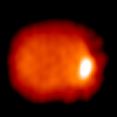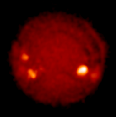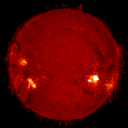


The middle image is taken at 1.4 GHz, and penetrates lower into the atmosphere where hot dense regions known as active regions become visible. These are the sites of activity in the Sun's atmosphere, and the gas in these regions is particularly hot. The cause of the heating which makes the Sun's corona so hot (millions of degrees) is still not understood and is an active area of research for astronomers who study the Sun.
The rightmost image is taken at 5 GHz and penetrates deeper still into the atmosphere. Here the brightest radio emission comes from a sunspot from which strong magnetic fields rise up into the solar atmosphere. The long dark lines on the east (left) limb of the Sun are due to some unidentified cool filaments of material trapped in the atmosphere above the surface, whereas the long dark line to the right of the Sun is a region where there is very little gas in the corona.
All these image were made with the Very Large Array radiotelescope in New Mexico, operated by the National Radio Astronomy Observatory.